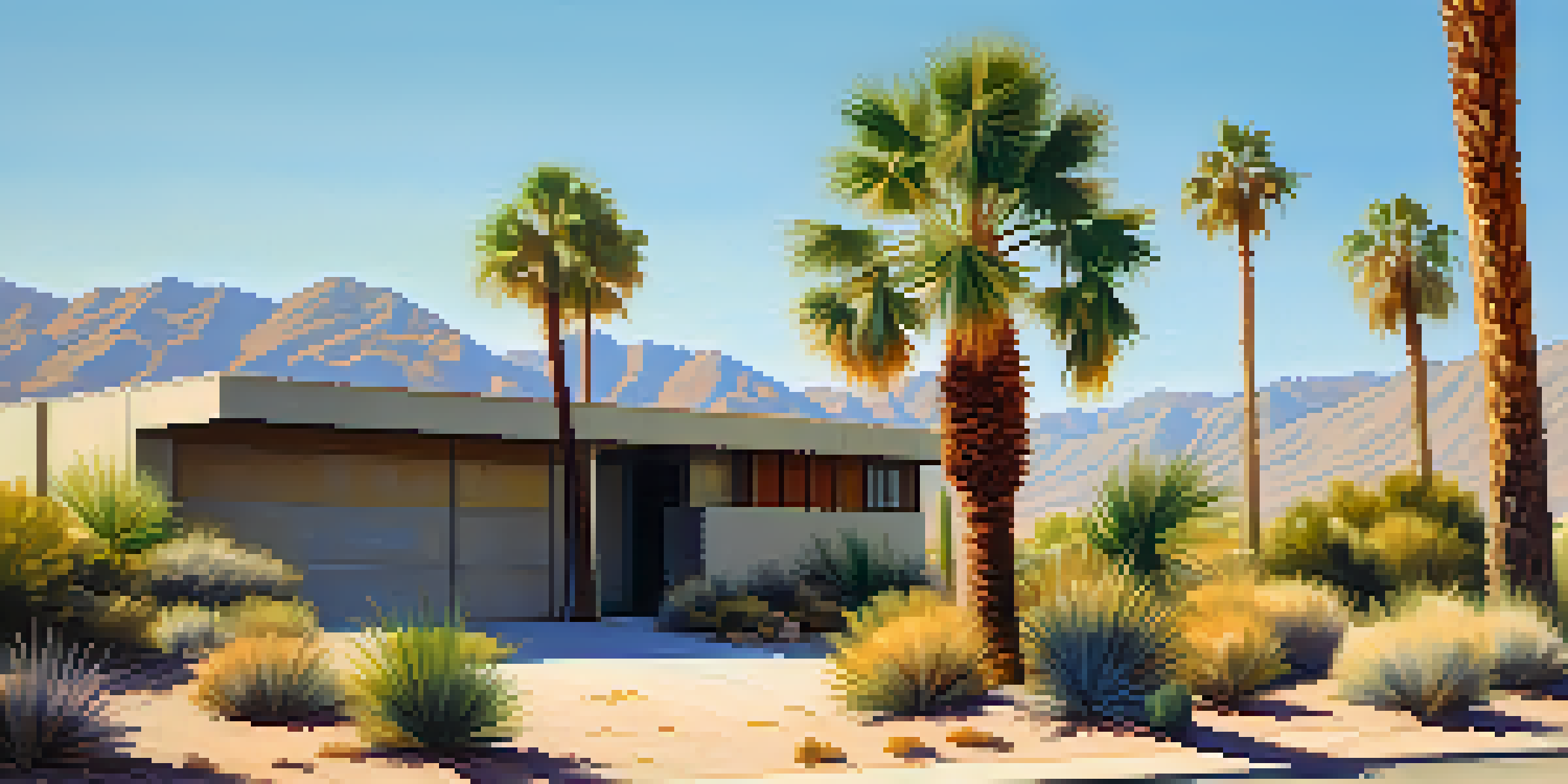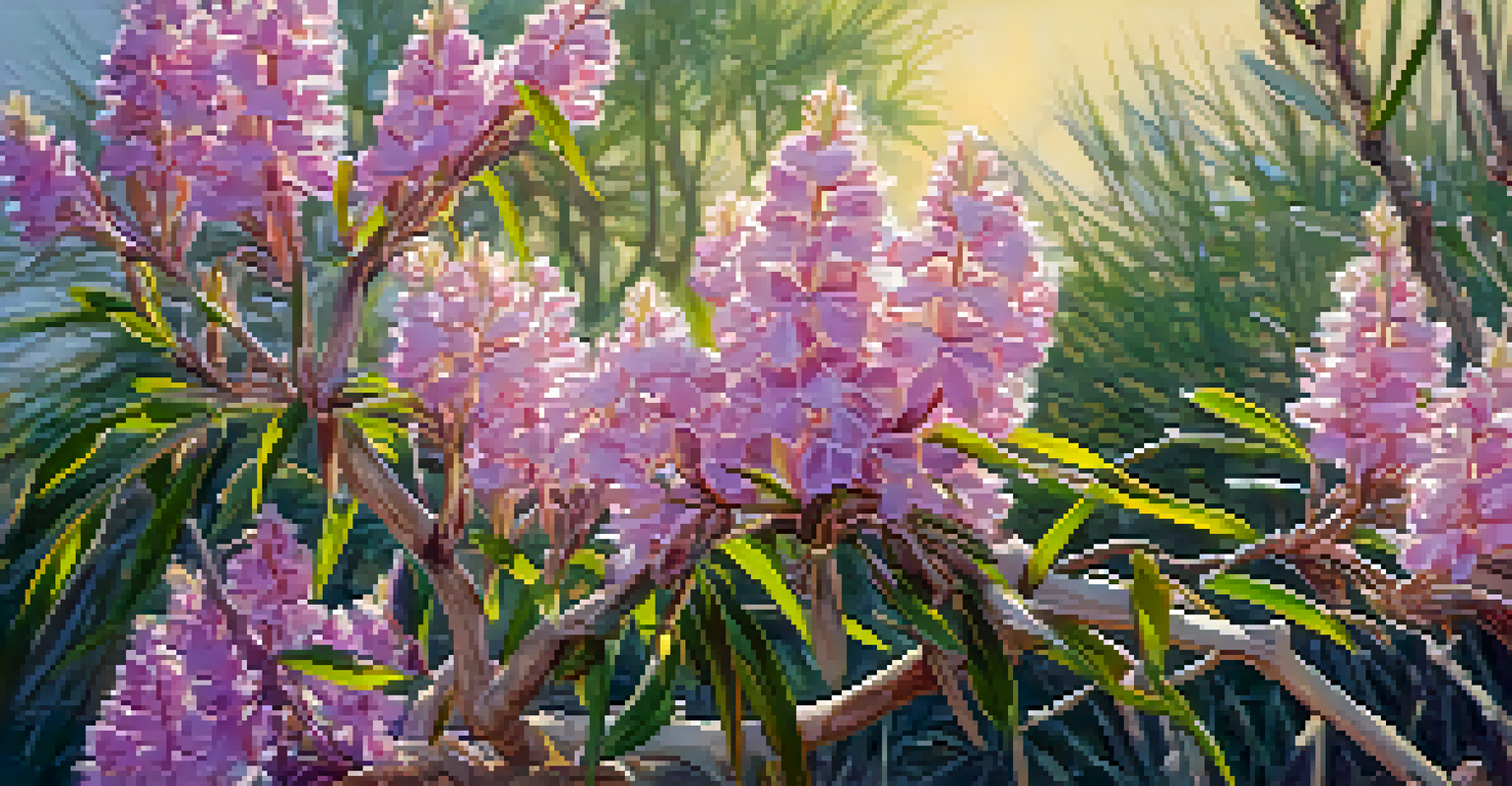Native Plants of Palm Springs: A Botanical Garden Guide

Introduction to Palm Springs' Unique Ecosystem
Palm Springs, nestled in the Coachella Valley, boasts a unique desert ecosystem that is home to a variety of native plants. These plants have adapted to the arid climate, thriving in conditions that would challenge many other species. Understanding this ecosystem is essential for both conservation and appreciation of the area's natural beauty.
In every walk with nature one receives far more than he seeks.
The desert landscape is not just barren; it’s a vibrant tapestry of life that plays a critical role in the local environment. Native plants provide essential habitats for wildlife and contribute to the overall health of the ecosystem. By familiarizing ourselves with these plants, we can better appreciate their role and importance.
As we delve into the specific native plants of Palm Springs, we’ll uncover not only their beauty but also their ecological significance. This exploration will enhance our understanding of the region's biodiversity and encourage us to protect these natural treasures.
Common Native Plants Found in Palm Springs
Among the most common native plants in Palm Springs is the California Fan Palm, a striking tree that provides shade and habitat. Its fronds swaying in the desert breeze are a familiar sight, offering a visual reminder of the region's natural heritage. This palm is not only iconic but also essential for various bird species that rely on it for nesting.

Another noteworthy native is the Desert Willow, known for its beautiful, trumpet-shaped flowers that attract pollinators. This tree thrives in dry conditions and showcases the resilience of desert flora. Its blossoms create a stunning contrast against the arid backdrop, making it a favorite among local gardeners.
Value of Native Plants in Ecosystems
Native plants are essential for maintaining the health and biodiversity of Palm Springs' unique desert ecosystem.
Additionally, the Creosote Bush is a quintessential desert plant characterized by its aromatic leaves and yellow flowers. It serves as a vital source of food and shelter for insects and small animals. The presence of these native plants not only enhances the landscape but also supports the intricate web of life in Palm Springs.
The Importance of Native Plants in Conservation
Native plants play a crucial role in ecosystem conservation, particularly in desert regions like Palm Springs. They are well-adapted to local soil and climate, requiring less water and maintenance compared to non-native species. By planting native flora, we can promote sustainability and reduce the strain on water resources, which is particularly vital in arid environments.
The clearest way into the Universe is through a forest wilderness.
Moreover, native plants support local wildlife, providing food and habitat for birds, insects, and other animals. This symbiotic relationship is essential for maintaining biodiversity and ensuring the health of the ecosystem. When we prioritize native plants in our gardens and landscapes, we contribute to a balanced environment.
By understanding the significance of these plants, we can make informed choices in landscaping and gardening. Embracing native species not only beautifies our surroundings but also fosters a deeper connection to the natural world and its preservation.
Creating a Native Plant Garden in Palm Springs
Designing a native plant garden in Palm Springs can be a rewarding endeavor that enhances both your outdoor space and the local ecosystem. Start by selecting plants that are well-suited to the desert climate, such as the Desert Sage or the Sand Verbena. These plants not only require minimal water but also provide stunning blooms that attract pollinators.
Consider grouping plants with similar water and sunlight needs to create a cohesive and low-maintenance garden. Incorporating features like rock gardens or dry riverbeds can mimic natural desert landscapes, adding visual interest and functionality. This approach not only conserves water but also supports local wildlife.
Creating a Sustainable Garden
Designing a native plant garden can enhance local wildlife habitats while requiring minimal water and maintenance.
Finally, be sure to research local resources or consult with native plant societies. They can offer invaluable guidance on plant selection and maintenance, ensuring your garden thrives. By fostering a native plant garden, you contribute positively to the environment while enjoying a beautiful, sustainable landscape.
Seasonal Changes in Palm Springs' Native Flora
One of the fascinating aspects of native plants in Palm Springs is how they respond to seasonal changes. In the spring, many plants burst into vibrant bloom, showcasing an array of colors that transform the desert landscape. This seasonal display not only captivates residents and visitors alike but also attracts various pollinators, creating a lively ecosystem.
As summer approaches, some plants enter a period of dormancy, conserving water and energy until cooler temperatures return. This adaptation is a testament to the resilience of desert flora and their ability to thrive under challenging conditions. Observing these changes can deepen our appreciation for the natural cycles of life in the desert.
Fall and winter bring their own unique beauty, with certain plants showcasing stunning seed heads or changing foliage. This dynamic nature of native plants serves as a reminder of the importance of seasonal rhythms and our connection to the environment. Embracing these cycles can inspire us to be more mindful of the natural world.
Wildlife Interactions with Native Plants
Native plants in Palm Springs play a vital role in supporting local wildlife, creating a thriving ecosystem. For instance, the nectar from Desert Lilies attracts hummingbirds, while the seeds of the Indian Rice Grass provide food for various bird species. This interconnectedness highlights the importance of preserving native plants for the survival of local fauna.
In addition to birds, native plants serve as critical habitats for insects, including bees and butterflies. These pollinators are essential for plant reproduction and contribute to the overall health of the environment. By cultivating native plants, we can create inviting spaces for wildlife, enhancing biodiversity in our gardens.
Seasonal Beauty and Resilience
Palm Springs' native plants exhibit stunning seasonal changes, showcasing their resilience and adaptability to the desert environment.
Observing the interactions between native plants and wildlife can be a delightful experience. Whether it's watching bees buzzing around blossoms or spotting birds nesting in trees, these moments remind us of the beauty of nature. By protecting and promoting native flora, we support the intricate relationships that sustain our local ecosystems.
Resources for Learning About Native Plants
If you're eager to learn more about native plants in Palm Springs, there are plenty of resources available to guide you. Local botanical gardens often host workshops and educational programs focused on native flora. These hands-on experiences can deepen your understanding and appreciation of the plants in your area.
Books and online databases provide valuable information about native species, their characteristics, and their ecological roles. Websites like the California Native Plant Society offer extensive resources and community connections to help you get started. Exploring these materials can empower you to make informed decisions about gardening and conservation.

Finally, consider joining local gardening clubs or native plant societies. Engaging with like-minded individuals fosters a sense of community and shared passion for preserving the unique flora of Palm Springs. Together, we can cultivate a deeper appreciation for our natural surroundings and work towards a more sustainable future.